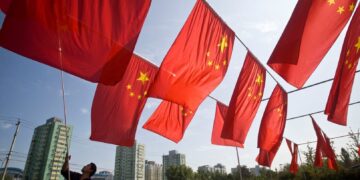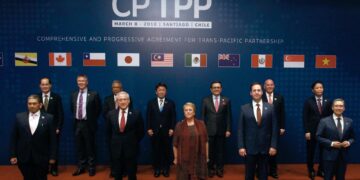Editor’s Note: This essay is excerpted from the book, Trouble in the Middle: American-Chinese Business Relations, Culture, Conflict, and Ethics and reprinted with permission of Routledge. Read an interview with the author here.
The American-Chinese disagreements over intellectual property rights (IPR) are clear examples of “trouble in the middle,” though the problems go far beyond cultural incompatibility to include political, economic, and historical conflicts. The problems are so broad, numerous, and contradictory that it is difficult to ethically evaluate the legitimacy of IPR in the China context. On the one hand, it seems simple enough. The Chinese voluntarily agreed to provide IP protection as part of seeking and accepting World Trade Organization (WTO) membership. But once they were accepted into WTO membership and began to benefit from membership privileges, they provided little IP enforcement. This would seem to be wrong, and certainly many American executives say so.
But there is more to the story. For one, all developing countries tend to be IPR violators. Certainly this applied to Taiwan, Singapore, and South Korea before they reached more advanced stages of economic development. Indeed, the United States was a major violator in its earlier development. The fact is that developing nations cannot compete with developed nations in most areas of IP; if they follow international accords, which were created by developed nations, they would be agreeing to forgo access to much IP, the wealth it generates, and the economic development it makes possible. This would have significant implications for their self-sufficiency, national security, and level of economic growth. Developing nations need an extended period of “transition,” during which they do not have to meet international IPR enforcement standards, to secure their legitimate economic development requirements.
This is an all-the-more-sensitive issue for the Chinese because of the military and economic aggression they suffered at the hands of the West in previous centuries. They rightfully do not trust the West, given their experience.
The Chinese also understand IP differently than the West. Their collective social orientation leads them to put a lower value on individual rights than does the West. The economic argument for IPR is not cut and dried. A balance is always required between the motivated entrepreneur and his access to public information. Reasonable people can disagree as to where exactly the line should be drawn. American culture, history, and institutions lead American policy makers to emphasize the role of the individual in innovation.
There is also the suggestive fact that American executives are mostly silent on the issue of IPR violations in China. If the problem is so bad, which it is, why is there not loud and consistent protest about it? The answer is fear of retaliation and fear of losing access to China. In other words, American companies are either making money in China or have other reasons to be there. In addition to lowering costs and accessing a booming market, many firms must attack Chinese competitors in China before bigger, stronger versions show up in their home markets. Foreigners go to China voluntarily. So even with significant IP risks, there are reasons to go there.
This brings up the utilitarian question: Who is benefiting in the China market? American retailers and consumers are benefiting from continually decreasing prices. This benefit accrues to millions of American consumers and the American businesses that use low-cost manufacturing in China to supply them and other global markets with low-priced goods. Also, American companies in China are selling into Chinese consumer, manufacturing, industrial, and other markets, providing raw materials, components, and finished goods. Hence, while American workers are losing jobs and American firms are losing business to manufacturing in China, American firms and consumers are benefiting from the same phenomenon. The situation is far from a clear loss for Americans.
This is one reason why the American government’s response to Chinese IPR violations is restrained. America is gaining considerably from China’s economic development. The Chinese are also funding American debt through the purchase of Treasury bonds. For these and other reasons, the United States government’s response has been somewhat contradictory, reflecting the complex economic and political relations between the two countries. China was named as an IPR violator in the feared US Special 301 list, but it also received American support to join the WTO, thus receiving most-favored-nation status and other benefits from the United States. It is an ambivalent, competitive relationship with strong positives and negatives for both countries.
In fact, probably the weakest stakeholder in the American-Chinese relationship and the one who has been subjected to the greatest hardship is the Chinese worker—though even here there are significant positives. Impoverished rural workers have voluntarily flocked to urban areas by the millions to take higher-paying jobs. These jobs, however, are often carried out in harsh work environments, where long hours, monotonous work, poor-to-nonexistent health and safety standards, nonexistent health and pension benefits, and abusive and uncaring management are common. The continuously falling price of goods that benefits American consumers and firms is made possible by the low pay and benefits given to Chinese workers. Counterfeit products also contribute to low prices that benefit American firms and consumers. IPR infringement is a good example of the complexity of the American-Chinese business relationship, providing both positive and negative outcomes. So while many Americans decry Chinese IPR infringement, they also benefit from it. They have much less to say about harm to the Chinese worker, but from this too they benefit.
In this context of significant American benefits, the legitimate development needs of a developing country, the lopsidedness of international IP laws that favor developed countries, legitimate cultural differences as to how to value the innovator rights–community rights dichotomy, legitimate policy differences as to how much rights protection is required to stimulate innovation, and the fact that the low price of goods from which Americans benefit is dependent on the mistreatment of Chinese workers, it is clear that the ethics of Chinese IPR infringement is a complex and multifaceted problem. Indeed, even if the Chinese government is committed to reducing infringement, it is not clear it could do so, or do so without harm to the country. To reduce infringement would definitely reduce employment, hinder growth, and present risks to the economic reforms. Not only does the government face extensive costs to try to curtail widespread counterfeiting in such a huge population, but if successful the likely rise in social unrest could destabilize the country. The government faces a dilemma; whatever decision it makes has problematic consequences. So to simply say the Chinese are unethical for not curtailing infringement is not persuasive.
Finally, there is a basic problem with the Communist Party itself. The Communist Party is above the law; it uses the law to pursue its power interests and social goals. Private property, let alone IP, does not depend on a system of laws and individual rights; it depends on the fluid and conflicting interests of the Communist Party leadership. So ultimately there cannot be IP in China until there is fundamental political change in China. Infringement is inseparable from the Party’s dictatorship. Just as the government is intimately involved in businesses of all types and government officials are privately involved in private businesses, the government is involved in infringement. Indeed, the anti-infringement officials participate in infringement. So the question of infringement in China cannot be separated from the structure of its political system.
American-Chinese conflicts over IP present a paradigm case of trouble in the middle. The middle is characterized by a complex array of interests, powers, benefits and costs, and cultural orientations. Including but well beyond cultural incompatibility, the difficulties involved in addressing IPR infringement present a complex thicket of mutually created and contradictory constraints and entanglements. No simple solution is possible to resolve the IP problem; any solution necessarily affects other important issues, benefits, and costs.
The result is an inability of either side alone, or the two together, to resolve the IP problem. The IP situation is not so much a problem as a part in a complex. This is why it is not resolved but functions as a slow-moving compromise, wherein changes in other issues present some opportunities for improvement, some worsening developments, and new constraints on action. It is trouble in the middle that will stay that way for the foreseeable future. Managing the process more than resolving the problem is the key task.
[author] Steven Feldman ([email protected]) is a professor of business ethics at the Weatherhead School of Management at Case Western Reserve University. This essay is excerpted from his book, Trouble in the Middle: American-Chinese Business Relations, Culture, Conflict, and Ethics. Reprinted with permission from Routledge. [/author]






























